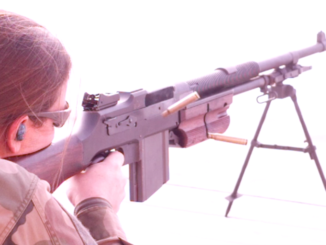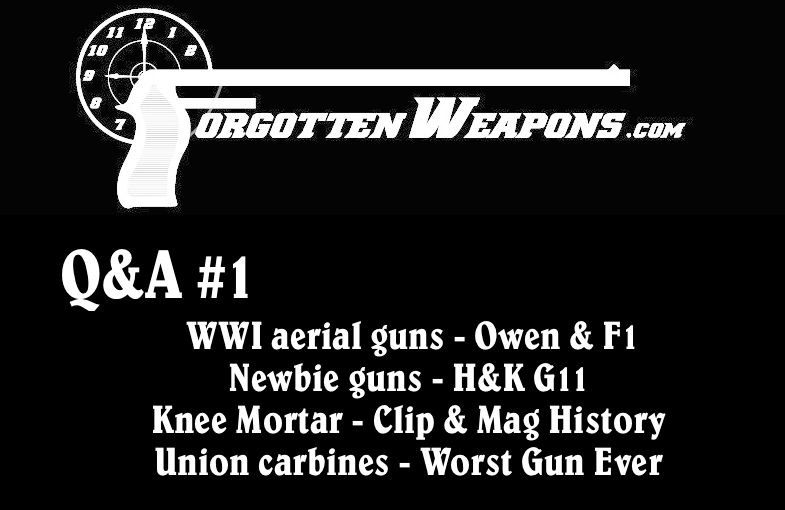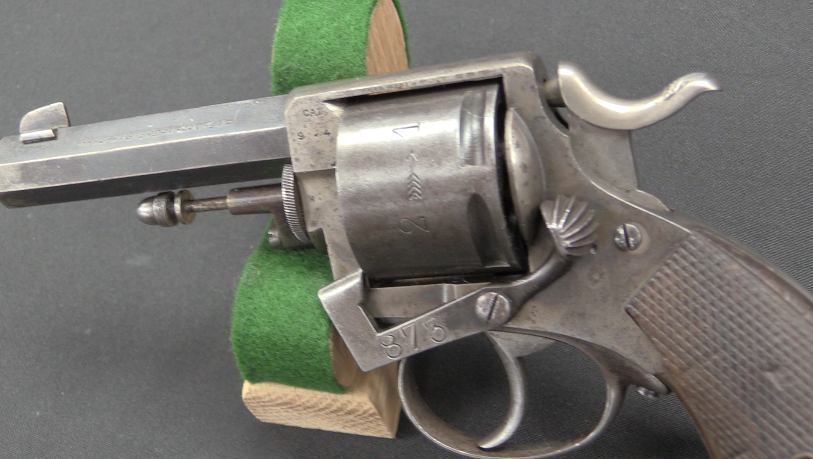Basically nothing is known about this rifle in terms of who created it or when – but it is a pretty interesting example of an attempt to convert a bolt action rifle to semiautomatic. This rifle began life as a standard Dutch Mannlicher rifle. The conversion was done here be splicing a Lewis Gun gas piston/op rod to the side of the barrel, and then modifying the bolt to work like a Lewis bolt, with a fixed firing pin and rotating cam in the bolt body. To top it off, the gas piston is driven not by a drilled gas port, but rather by a gas trap extension on the muzzle.
The bolt conversion work seems to have been done pretty well, but the receiver extension could hardly be any more crude. It cracked and broke off the original receiver at some point, and has been poorly welded back in place (mostly).
Thanks to the Dutch National Military Museum for allowing me access to film this rifle!




I love semi auto conversions. They are so optimistic. They seem like the kind of contraption a hobbyist would build today.
“They seem like the kind of contraption a hobbyist would build today.”
Repeating to self-loading conversion vary in design and quality of workmanship, some very refined as for example SNABB: https://www.forgottenweapons.com/snabb-semiauto-conversion/
The Lewis Gun in 6.5mm was the standard Dutch LMG at the time, so it would have made sense to use one as well as a Mannlicher rifle if one were noodling with such a semi-auto conversion. A shame in a way that two good guns were sacrificed to make this one, but it is of interest nonetheless.
I don’t know if a private Dutch citizen could have owned a Lewis Gun in the 1920s, or if this was the work of an official arsenal. It looks as if lots of armies were interested in semi-auto rifles in the 1920s, but none could quite take the plunge when they had so many bolt actions in stock. I am not surprised however that these conversions were not taken up, they seem to be far more trouble than they are worth.
This is number 199 in “Experimental and Trial” book by Mathieu Willemsen, curator (or former curator?) of the firearm collection of the Netherland Army Museum.
A wonderful book I recently spotted on Ian’s bookshelf in a Q&A video. Great photos with just enough text on each gun. And an interresting history of the Dutch school of musketry.
A lot of guns presented in this book deserves a Forgotten Weapons video.
Eliminating the straight portion of the cam slot in the bolt means that as soon as the piston begins to move, the bolt begins to rotate. Without any dwell time to allow pressure to drop. extraction problems could occur. I find the design somewhat sleek compared to other conversions, but the weak receiver and early unlocking suggest that the builder didn’t fully understand rifle pressures.
This looks a bit similar to the White LMG project. White’s prototype didn’t involve ripping up broken machine guns. I suspect that the donor for this rifle’s bolt and gas piston was none other than a Lewis gun with a burnt-out barrel. I could be wrong.
I like independent gun designers. J.C. White had a long run with guns that went nowhere. On the other hand, some obscure tinkerers such as Browning and Stoner hit it big. From what I can tell, a lot of JMB’s designs went from idea to production guns with a lot of help from Winchester’s professional staff. This gun may have benefited from such help.
Damaged guns were probably abundant right after WWI, so scrounging parts may not have been difficult. Feel free to disagree.
Well, you have to remember that John Moses Browning was himself the son of a gunsmith and designer. John Sr. built things like “harmonica magazine” repeating percussion rifles and etc. before the metallic cartridge came along. Also, JM’s brothers were gunsmiths and designers in their own right. In short, gun design was something that ran in his family.
Colt, Winchester, Remington and FN’s design staffs mainly “helped” Browning by taking his hand-carved wooden models and duplicating them in steel. There was rarely anything about his initial designs that required much “tweaking”, unless he did it himself. The evolution of the Colt-Browning self-loading pistol locked breech, from twin “parallel ruler” links, to single link, to cam path, is a good example; he came up with each successive evolution himself.
His major collaborators on subjects like the .50 cal M1921 HMG, the Remington Model 8 rifle, and his last major work, the FN GP pistol we now know as the P-35 High Power, were semi-independent “visionaries” like himself. Notable among them was Dieudonne Saive at FN, who later went on to design the SAFN self-loading rifle and lead the team that created the FAL.
As for Eugene Stoner, he was an aeronautical engineer who applied the operating principles and construction technology of aerospace engineering to firearms design. He also often got the blame for other people applying the Did Not Read The F***ing Manual principle to his designs. Hint; when a gun designer tells you “don’t use ball powder in my hyper-velocity small-bore automatic rifle with the direct gas-impingement system”, don’t use ball powder in it.
More than most industries, firearms design depends less on the “design team” approach than on the work of an individual who just happens to be good at that sort of thing. The individual may be an “organization man” on the face, but at heart, he’s somebody who sees the world through eyes not unlike Leonardo da Vinci’s.
Who (surprise!) was a gun designer, too.
cheers
eon
“More than most industries, firearms design depends less on the “design team” approach than on the work of an individual who just happens to be good at that sort of thing.”
Well, most Soviet-Russian fire-arms have name(s) of designer(s) in name, most often 1-2, sometimes 3.
“don’t use ball powder in it.”
I would say: before deploying make sure that your combination of weapon-ammunition works as it should.
Stoner and Browning didn’t start out famous, and others with similar backgrounds didn’t become famous. Advertising copy in the 1880’s didn’t say “designed by John Browning”.
To go from an idea to a production gun is non trivial. Georg Luger’s contribution to the Borchardt was exceptional. Stoner had Jim Sullivan and Bob Fremont on his design team to work on details. Usually one name stands out in a gun design, but somebody has to do the nitty gritty.
“donor for this rifle’s bolt and gas piston was none other than a Lewis gun with a burnt-out barrel”
Canadian HUOT automatic rifle was designed to utilize parts of ROSS repeating rifle
https://en.wikipedia.org/wiki/Huot_Automatic_Rifle
gives price of HUOT as 50 while Lewis LMG as 1000, although disproportion seems incredibly big for me, can anyone prove or deny it?
The Lewis gun’s price tag includes the licensing fee. That said, the Huot uses mostly domestic parts not covered by Lewis save for the barrel shroud. A handy conversion of an otherwise dirt sensitive weapon would have been thought cheaper than paying millions for licensed production. I could be wrong.
“early unlocking suggest that the builder didn’t fully understand rifle pressures.”
This might be just proof of concept, they conclude that it don’t work as intended and abandoned that development.
As a proof of concept, one question you might want to answer is “does it feed?” If the receiver fails after the first shot, it isn’t a well done experiment.